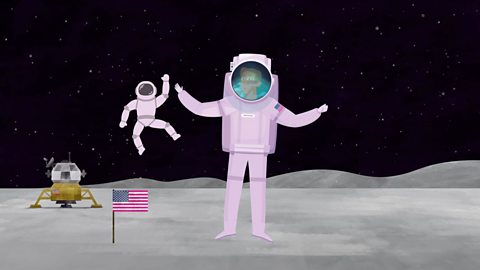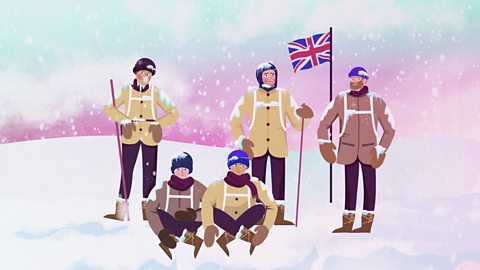OLLIE: Who shall we look up today, Fatima?
FATIMA: I’d like to meet a famous pilot.
OLLIE: Holo-Lab, can we meet a famous pilot?
HOLO-LAB: Searching. Searching… Famous pilot found… Amelia Earhart.
AMELIA EARHART: Hi there.
FATIMA: Hi, Amelia. I’m Fatima, and this is Ollie. I’m so happy to meet you.
AMELIA EARHART: Great to meet you too.
FATIMA: What was it like to fly planes in the 1930s?
AMELIA EARHART: In those early days, flying was so dangerous. Many people crashed. Back then, not many women flew planes. People thought it was something that only men did, but I wasn’t going to let that stop me.
OLLIE: Wow! That’s cool! What was the longest journey you made in a plane?
AMELIA EARHART: In 1932, I set out to become the first woman to fly on her own across the Atlantic Ocean. I flew 3,230 kilometres from Newfoundland, Canada, and I landed 15 hours later in Northern Ireland. You can see on this map here.
FATIMA: I’ve always wanted to know, what are those lines on the map for?
AMELIA EARHART: Those are the lines of latitude and longitude. Lines of latitude that run horizontally around the Earth, like the Equator across the middle there, tell you how far north and south you are. Lines of longitude that run vertically around the Earth, like the Prime Meridian down the middle there, tell you how far west or east you are. They can be used to generate coordinates, telling you precisely where you are in the world. I used them to navigate.
OLLIE: Was it hard?
AMELIA EARHART: It was really tough.
AMELIA EARHART: The weather was bad, the plane was hard to control. I had mechanical problems…But I made it all the way to Cudmore in Northern Ireland.
MAN: Have you flown far?
AMELIA EARHART: From Canada.
MAN: That’s thousands of miles away.
AMELIA EARHART: Yes, it is. Yes, it is.
FATIMA: How did your plane work, Amelia?
AMELIA EARHART: The engine drives the propeller and pulls the plane along. Air passes under and over the wing. As the plane gains speed, the air travels faster over the top of the wing than it can underneath, because of the shape of the wing. This difference in air resistance between the top and the bottom means that there’s higher pressure under the wing than above it. This causes it to lift. Remember, the plane is being pulled down by gravity, just like you are now. When there is enough lift to overcome the force of gravity, the plane takes off.
OLLIE: Wasn’t gravity invented by Sir Isaac Newton?
FATIMA: No, silly! Newton discovered gravity, he didn’t make it up – it was already there.
AMELIA EARHART: That’s right. Newton worked out loads of stuff about the world, like the law of physics that says one force must be greater than the opposite force for an object to move. With flight, the lift is acting in opposition to gravity and when it gets stronger, the plane can fly.
OLLIE: That’s incredible.
FATIMA: Didn’t you disappear on your last adventure?
AMELIA EARHART: That’s right. I set out to fly around the whole world in 1937, but I disappeared over the Pacific Ocean and was never seen again.
OLLIE: Where did you go to?
AMELIA EARHART: That’s a secret. Maybe one day you’ll find out.
FATIMA: Thank you for talking to us, Amelia Earhart.
AMELIA EARHART: Goodbye folks.
OLLIE: Goodbye Amelia.
FATIMA: Goodbye Amelia.
Video summary
The life of Amelia Earhart, a courageous pilot who broke records in the air, is introduced to primary pupils in this short animated film.
It provides the perfect backdrop to cross-curricular learning, as we explore journalistic writing and interviews, calculating distances and speed, forces and Newton’s Law, maps and distance and the history of flight.
This short film is from the BBC series, Explorers.
Teacher Notes
This short film could be used as an introduction to a cross-curricular topic focused on the life and adventures of Amelia Earhart.
Your class could study Amelia Earhart in the context of other explorers or in the context of other inspiring women and their achievements. Alternatively the film could be used as part of a cross-curricular topic on flight.
There is lots of scope for working on geographical skills using Amelia Earhart's journeys as a starting point:
- You could look at maps of the world to track her journeys, e.g. across the Atlantic or across the United States of America, identifying key places that she passed.
- The film explains what lines of longitude and latitude are, as well as the Prime Meridian, which pupils could explore further.
- Your class could track Earhart's route around the world, pointing out that she attempted to follow the equator.
You could also use mathematical skills to work out the distances she traveled and pupils could carry out calculations around conversion of units, for example convert distances she traveled from miles to kilometres, or times from hours to minutes. For example her first transatlantic solo flight took 14 hours, 56 minutes. What is this in hours / minutes / seconds? What average speed did she travel at?
The film introduces elements of the science of flight and discusses forces such as air resistance and gravity as well as introducing Newton's laws:
- You could use this as a starting point for further work on forces, or introduce more learning about history by studying the story of flight.
- You could carry out fair tests investigating air resistance using parachutes or paper aeroplanes.
This film provides a great stimulus for writing:
- Pupils could pretend to be journalists, reporting on Earhart's remarkable adventures as she crossed the Atlantic.
- Alternatively you could use her life as a basis for biographical writing.
- You could use desktop publishing software to create a comic strip of her life and adventures.
- Pupils could also write fiction inspired by her adventures, describing what it feels like to fly a plane, and imagining where they would fly to and what they would see from their plane.
In art lessons pupils could draw or paint birds eye views of different landscapes, as seen from an aeroplane, or look at drawings of aeroplanes and create their own aviation art.
This short film could be used to study a variety of cross-curricular topics at KS2 in England and Northern Ireland, Progression Step 3 in Wales and 2nd Level in Scotland. Including;
- Maths
- Geography
- English
- History
- Art and design
- Science
More from Explorers
Neil Armstrong. video
Neil Armstrong's historic voyage to the Moon is explored in this short animated film for primary pupils.

Christopher Columbus. video
This short animated film for primary pupils takes a look at Christopher Columbus' epic adventures to the Americas and the changes in travel and exploration over time.

Robert Falcon Scott. video
Robert Falcon Scott's ill-fated journey to the South Pole is brought to life in this short animated film for primary pupils.

Ibn Battuta. video
Through Ibn Battuta's epic 29-year journey, primary pupils can explore core learning topics such as creative writing, pilgrimage, Hajj and early Islamic civilisation.
